原文地址:Unnatural selection: How humans are driving evolution
Humans are not only causing a mass extinction – we are also the biggest force in the evolution of the species that will survive
THE Zoque people of Mexico hold a ceremony every year during which they grind up a poisonous plant and pour the mixture into a river running through a cave (pictured below). Any of the river's molly fish that float to the surface are seen as a gift from the gods. The gods seem to be on the side of the fish, though - the fish in the poisoned parts of the river are becoming resistant to the plant's active ingredient, rotenone.
If fish can evolve in response to a small religious ceremony, just imagine the effects of all the other changes we are making to the planet. We are turning grassland and forests into fields and cities, while polluting the air and water. We are hunting species to the brink of extinction and beyond, as well as introducing new pests and diseases to just about every part of the world. And that's not to mention drastically altering the climate of the entire planet.
It is no secret that many - perhaps even most - species living today are likely to be wiped out over the next century or two as a result of this multiple onslaught. What is now becoming clear is that few of the species that survive will live on unchanged.
Far from being a slow process, evolution can occur extremely rapidly when the environment changes (New Scientist, 2 April, p 32). So, as we alter the planet ever faster and more drastically, we are becoming the main force driving evolution. "The intensity of the ecological effect of man is pretty obvious," says Stephen Palumbi of Stanford University in California. "There is an amazing amount of evolutionary change as a result."
Some of the fastest rates of evolution ever measured in the wild are in plants and animals harvested by humans. The few populations for which we have data are, on average, evolving three times as fast as populations subject only to natural pressures, for example.
Over the following pages, we look at the many ways in which plants and animals are already evolving in response to human pressures. Some of these changes, such as animals evolving to survive in highly polluted areas, can be seen as a positive thing. Others are bad from our point of view, such as animals we hunt losing the traits we value most in them, or pests becoming immune to poisons. What is clear is that whether the issue is growing enough food, conserving wild animals or keeping our beds bug-free, human-driven evolution is a factor we can no longer afford to ignore.
Unnatural selection: Hunting down elephants' tusks
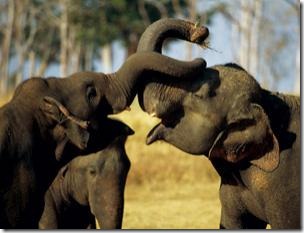
Most predators target the young or the weak. We are different, targeting the biggest and best, or those with characteristics we desire, such as large antlers. Combine this with our ability to kill in great number and the result is extremely rapid evolution of our prey.
The first clear evidence was published in 1942, and since then many examples have emerged of how hunting can transform the hunted. The targeting of large animals has resulted in a fall in the average size of caribou in some areas, for instance, while trophy hunting has led to bighorn sheep in Canada and mouflon in France evolving smaller horns.
Perhaps the most dramatic example is the shrinking of tusks in elephants, or even their complete loss. In eastern Zambia, the proportion of tuskless female elephants shot up from 10 per cent in 1969 to nearly 40 per cent in 1989 as a result of poaching (African Journal of Ecology, vol 33, p 230). Less dramatic rises in tusklessness have been reported in many other parts of Africa, with some bull elephants losing tusks too.
Humans have had an even bigger impact in Asia. Only male Asian elephants have tusks, and the proportion of tuskless bulls has soared in many areas. In Sri Lanka, where there has been a lot of poaching, under 5 per cent of males now have tusks, says Raman Sukumar of the Indian Institute of Science in Bangalore, who studies Asian elephants. Simulations by Ralph Tiedemann of the University of Potsdam in Germany and colleagues suggest that female elephants' preference for tuskers has partly counteracted the effect of hunting. However, even if all poaching stopped, it would take a very long time for the percentage of tuskers to rise again.
It's not just animals that are being shaped by human preferences: the harvesting of wild plants can have a similar effect to hunting and fishing. In Tibet, for example, the height of the snow lotus at flowering has nearly halved over the past century as a result of the flowers being picked for use in traditional medicine (Proceedings of the National Academy of Sciences, vol 102, p 10218).
To even the balance, some biologists are now promoting the idea of counteracting the evolutionary pressures of hunting through "compensatory culling" - killing animals with undesirable traits. This has actually long been done in some places. In Germany and Poland, for instance, there is a tradition of shooting yearling deer with poor antlers to prevent a decrease in the antler size of mature stags.
Private reserves in countries such as Zimbabwe have a similar policy. They typically charge hunters a smaller "trophy fee" for shooting tuskless elephants - $3000 versus at least $12,500 for a tusker, for example. This is partly because tuskless animals are less valuable, but it is also a deliberate attempt to eliminate the trait.
Unnatural selection: The race against climate change
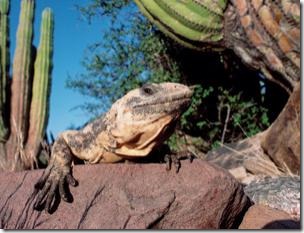
In Finland, the tawny owl used to be mainly grey. But since the 1960s, the proportion of a brown subtype has risen fast. "The frequency averaged around 12 per cent in the early 60s and has increased steadily to over 40 per cent nationwide," saysPatrik Karell of the University of Helsinki, whose findings were published earlier this year (Nature Communications, DOI: 10.1038/ncomms1213).
His team found that grey owls (pictured above right) have an advantage over brown ones only when there is lots of snow. As winters have become milder, the brown subtype has thrived. It is possible that this is because brown owls are better camouflaged when there is less snow, but it could also be because brown coloration is linked to another characteristic, such as higher energy needs.
There are countless examples of how global warming is affecting life, from plants flowering earlier in spring, to species spreading to areas that were once too cold for them to survive, to birds becoming smaller. The vast majority of these changes are not genetic but due to plasticity: organisms' built-in ability to change their bodies and behaviour in response to whatever the environment throws at them. At least a few species, however, like the owls of Finland, are already changing genetically - evolving - in response to climate change.
In North America, for instance, pitcher plant mosquitoes lay their eggs in pitcher plants and the larvae enter a state of dormancy in the winter months before resuming development in spring. Dormancy is genetically programmed, triggered not by falling temperature but by the shortening days. As the growing season has lengthened, mutant mosquitoes that keep feeding and growing for longer have thrived. Northern populations now go dormant more than a week later than in 1972, when studies began.
The earlier breeding of red squirrels in North America is also thought to be partly a result of genetic changes. Some families emerge earlier in spring, and they are doing better as the climate shifts.
Plants are changing too. When seed collected from field mustard plants (Brassica rapa) in California in 1997 and 2004 were grown in identical conditions, the 2004 strains flowered 9 days earlier on average (Proceedings of the National Academy of Sciences, vol 104, p 1278). The change was a result of drought - the plants have evolved to reproduce before they run out of water.
Rapid evolution is thus already helping some species adapt to a warming world, but it is no "Get out of jail free" card. For instance, so far pied flycatchers in the UK seem unable to shift to laying eggs earlier in spring. And according to one model that specifically takes rapid evolution into account, global warming will kill off 20 per cent of all lizard species by 2080. The problem for lizards is that as the climate warms, they have to spend more time in the shade and less time feeding.
Organisms with long generation times and slow reproductive rates are the least able to evolve, says Stephen Palumbi at Stanford University. "And they are the ones that are already threatened. It's a double whammy."
Even species whose evolution has kept pace with the slight warming so far will not necessarily keep up as the global temperature soars by another 4 °C or more. Rapid evolution generally depends on the existing variation within a population, rather than on new mutations. "It is limited to the kind of changes that can happen quickly," Palumbi says.
In fact, there is a catch-22 to very rapid evolution - the faster organisms evolve, the less able they are to evolve further. This is because fast change occurs when only a small proportion of each generation manages to reproduce, resulting in a dramatic loss of genetic diversity - the fuel for further evolution. In many cases, the size of populations will also plummet, rendering them vulnerable to extinction. "You could evolve really fast but just not make it," says Michael Kinnison of the University of Maine in Orono.
Unnatural selection: Living with pollution
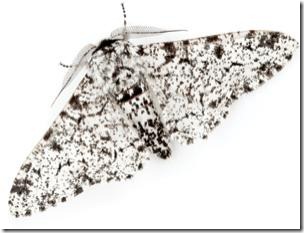
Between 1947 and 1976, two factories released half a billion kilograms of chemicals called polychlorinated biphenyls (PCBs) into the Hudson river, in the north-east US. The effects on wildlife weren't studied at the time, but today some species seem to be thriving despite levels of PCBs, many of which are toxic, remaining high.
At least one species, the Atlantic tomcod - an ordinary-looking fish about 10 centimetres long - has evolved resistance. "We could blast them with PCBs and dioxins with no effect," says Isaac Wirgin of New York University School of Medicine.
Many of the ill effects of PCBs and dioxins are caused by them binding to a protein called the hydrocarbon receptor (Science, vol 331, p 1322). The Hudson tomcod all have a mutation in the receptor that stops PCBs binding to it, Wirgin and colleagues reported earlier this year. The mutation is present in other tomcod populations too, Wirgin says, but at low levels.
The most famous example of evolution in action was a response to pollution: as the industrial revolution got under way, cream-coloured peppered moths in northern Britain turned black to stay hidden on trees stained by soot. As the tomcod shows, though, most evolutionary changes in response to pollution are invisible.
The spoil heaps of many old mines, for instance, are covered in plants that appear normal, but are in fact growing in soil containing high levels of metals such as copper, zinc, lead and arsenic that would be toxic to most specimens of these and other species. The evolution of tolerance has occurred extremely rapidly in some cases, sometimes within just a few years of the soil being contaminated.
With very widespread pollutants, it is much harder to show that organisms are evolving in response, because all populations change at once. The comparison has been done with a common weed called plantain (Plantago major), though. Ground-level ozone, produced when sunlight strikes car exhaust fumes, greatly impairs the growth of plants. When researchers grew plantain seeds collected in 1985 and 1991 from a site in northern England where ozone pollution reached very high levels in 1989 and 1990, they found that the plants from the 1985 batch grew nearly a third more slowly when exposed to ozone, whereas the growth of those from 1991 fell by only a tenth (New Phytologist, vol 131, p 337).
Since even the remotest parts of the planet are now polluted in one way or another, it is likely that many plants and animal populations have evolved some degree of tolerance, even though few cases have been documented. "Nobody looks for resistance," says Wirgin. "My guess is that if you look you will find a lot of it." His own discovery was entirely accidental: the team had set out to study liver cancers, and they only noticed the tomcod's resistance when blasting the fish with PCBs failed to produce any tumours.
However, there are obviously limits to what evolution can achieve. This is especially true for small populations that reproduce slowly and have few offspring, such as the Yangtze river dolphin. Pollution is thought to have contributed to its extinction.
What's more, pollution resistance in one species can have unexpected consequences for others. The tomcod's tolerance allows it to accumulate extraordinarily high levels of PCBs in its body, for instance, which are a threat to animals higher up the food chain - such as humans with a taste for these reportedly delicious fish.
Unnatural selection: Spreading sickness
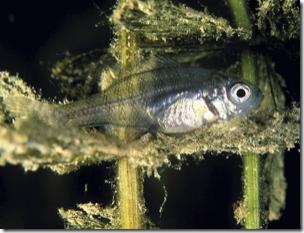
Perch in Lake Windermere in the UK used to live to a ripe old age. While the average age of fish caught and released by researchers was around 5 years, a few individuals were as old as 20. Then in 1976, an unidentified disease wiped out 99 per cent of adult fish and continued to preferentially kill older fish for years afterwards. Since then, no fish older than 7 have been caught.
According to Jan Ohlberger of the University of Oslo, Norway, the perch (Perca fluviatilis) evolved very quickly in response. They now become sexually mature at an earlier age, which increases their chances of breeding before they get killed by the disease (Proceedings of the Royal Society B, vol 278, p 35).
While the disease is thought to have spread naturally in the lake, Ohlberger points out that many devastating disease outbreaks in plants and animals are a result of human activity. To mention just a few: Dutch elm disease was caused by fungi introduced from Asia; lions were hard hit by canine distemper spread by village dogs, and corals are far more susceptible to diseases when water temperatures are abnormally high, which is happening often as a result of climate change.
Anything that kills a significant proportion of a population has the potential to bring about very fast evolution. In frogs there is now some evidence of this: last year several research groups reported that some populations appear to be becoming resistant to a fungus that has decimated many amphibian species. It is also clear that human populations have sometimes evolved rapidly in response to diseases such as kuru, which attacks the nervous system.
So it seems plausible that by spreading diseases or creating the conditions in which they thrive, humans are indirectly forcing many organisms to evolve. "I think this is a common phenomenon and has not yet been described because it is simply hard to prove," says Ohlberger. He points out that the long-running capture-and-release programme at Lake Windermere, which began in 1943 and just happened to coincide with the disease outbreak in perch, is pretty unique. In most cases we know too little about what populations were like before disease outbreaks to be able to tell if and how they have evolved in response.
Unnatural selection: The arms race against pests
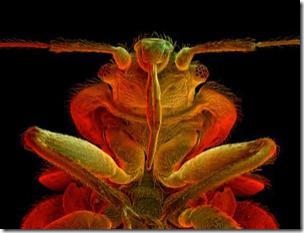
Had any strange itchy bites or rashes recently? You might have fallen victim to bedbugs. The little bloodsuckers are back in a big way, thanks in part to the fact that, like head lice and human fleas, they have evolved resistance to many common pesticides.
Whatever their drawbacks, there is no doubt that pesticides have made a huge difference to our lives. They have helped eliminate diseases like malaria from some areas and made possible the switch to intensive farming. As soon as we started using them, though, resistance began to evolve.
"Insects that succumb readily to kerosene in the Atlantic states defy it absolutely in Colorado [and] washes that easily destroy the San José scale [insect] in California are ridiculously ineffective in the Atlantic states," wrote entomologist John Smith in 1897 - the first known report of insecticide resistance.
The use of synthetic pesticides like DDT took off in the 1940s. Resistant houseflies were discovered in 1946. By 1948, resistance had been reported in 12 insect species. In 1966, James Crow of the University of Wisconsin-Madison reported that the count had exceeded 165 species. "No more convincing examples of Darwinian evolution could be found than those provided by the development of resistance in one species after another," he noted at the time.
It's not just bugs. Rats and mice around the world have become resistant to the poison warfarin, and in Europe some have even become resistant to warfarin's replacement, superwarfarin (Journal of Toxicological Studies, vol 33, p 283). In Australia, meanwhile, rabbits are becoming resistant to the poison used to control their numbers, called Compound 1080.
Because of its economic importance, pesticide resistance has been studied far more closely than other kinds of ongoing evolution. In many cases we know which mutations are involved, how they make organisms resistant and sometimes even how the mutations spread through populations.
Resistance often arises due to mutations that alter the shape of proteins and thus prevent insecticides binding to their targets. For instance, DDT and pyrethroid compounds kill insects by opening sodium ion channels in nerve cells, but in the malaria-carrying mosquito Anopheles gambiae, variants of the channels that cannot be opened this way have evolved on at least four separate occasions (PLoS One, vol 2, p e1243).
The other main mechanism of resistance involves enzymes that inactivate pesticides before they can kill. Some resistant strains of A. gambiae, for instance, produce large quantities of an enzyme called CYP6Z1 that can inactivate DDT.
Pesticide resistance is becoming such a serious problem that strategies for preventing it evolving in the first place are taken increasingly seriously. One approach is to alternate the type of pesticide applied, to try to avoid applying sustained selective pressure in one direction.
At present, though, the pests seem to be evolving faster than we can develop new pesticides. In one region of Burkina Faso, A. gambiae has become resistant to all four classes of insecticides used for malaria control.
Unnatural selection: Introducing invaders
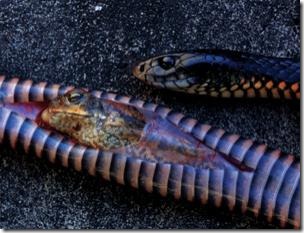
In 1935, the South American cane toad was introduced to Australia to control pests feeding on sugar cane. The cane fields were not to the toad's liking, but the rest of the countryside was. The toad has spread rapidly at the expense of many native species.
The highly poisonous animals are having a big effect on predators. Some, such as the Australian black snake, are developing resistance to cane toad toxins. Others, such as the red-bellied black snake and green tree snake, are changing in a more surprising way - their mouths are getting smaller. The reason is simple: snakes with big mouths can eat large toads that contain enough toxin to kill them.
The toads themselves are also changing. Some are now colonising regions that were too hot for the founder population, suggesting that they are evolving tolerance to more extreme conditions. What's more, the toads leading the invasion are becoming better colonisers: they have bigger front legs and stronger back legs than toads living in the areas already colonised. Radio tagging has confirmed that these "super-invader" toads can travel faster, as you might expect. They are probably evolving because the first toads to reach new areas benefit from more food and less competition, and thus have more offspring. The changes are likely to be transient, though - once the toads stop spreading, the "super-invader" traits will gradually be lost.
Ships and planes have turned the natural trickle of species spreading to new islands or continents into a raging torrent, and the new arrivals sometimes have a dramatic effect. In areas of the US that have been invaded by fire ants, for instance, native fence lizards have evolved longer legs. They need them: given the opportunity, a dozen fire ants can kill a lizard in minutes.
Rather than simply study the results of invasions, Michael Kinnison of the University of Maine in Orono and colleagues have been actively experimenting. In one experiment, his team moved juvenile chinook salmon from one river in New Zealand to another. The salmon were introduced to the country around a century ago, and Kinnison wanted to assess the extent to which they had adapted to conditions in individual rivers. He found drastic differences in survival, even though the fish appear identical (Canadian Journal of Fisheries and Aquatic Sciences, vol 60, p 1). "When a population was locally adapted, it performed twice as well," he says.
Kinnison suspects that lots of small changes can add up to make a huge difference to a population's success. "Contemporary evolution may be relatively modest on a trait-by-trait basis, but its overall contribution to the performance of populations may be immense," he says.
Such findings help explain why there is often a lag between the introduction of new species and their rapid spread. A newly arrived species is likely to find itself in an environment that is not quite ideal, and its population may be very small, meaning there is little genetic diversity. In these circumstances, a species will spread only slowly, if at all.
As the population begins to adapt to local conditions, though - perhaps via invisible changes such as mutations in immune genes - it is likely to start to grow and spread. Because more mutations occur in larger populations, it will then evolve faster, enabling it to spread quicker and further. If this turns out to be common, it is bad news. It suggests that many introduced species that seem to be behaving themselves could yet start spreading explosively and cause serious problems.
 转发至微博
转发至微博
0
推荐




 京公网安备 11010502034662号
京公网安备 11010502034662号 